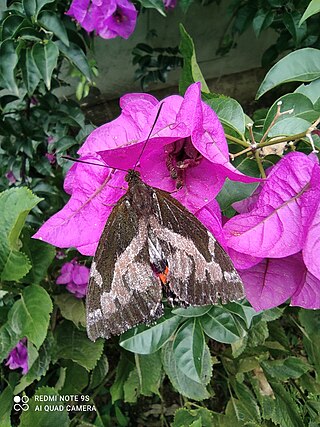
Maylandia estherae is a haplochromine cichlid. It is a rock dwelling fish or mbuna from Lake Malawi. This fish, like most cichlids from Lake Malawi, is a mouthbrooder - females hold their fertilized eggs then fry in their mouths until they are released after about 21 days.

Castniidae, or castniid moths, is a small family of moths with fewer than 200 species: The majority are Neotropical with some in Australia and a few in south-east Asia. These are medium-sized to very large moths, usually with drab, cryptically marked forewings and brightly coloured hindwings. They have clubbed antennae and are day flying, and are often mistaken for butterflies. Indeed, some previous classification systems placed this family within the butterflies or skippers. The Neotropical species are commonly known as giant butterfly-moths, the Australian and Asian species as sun moths. The larvae are internal feeders, often on roots of epiphytes or on monocotyledons.

Paysandisia archon is a moth of the family Castniidae. It is native to Uruguay and central Argentina and has been accidentally introduced to Europe, where it is spreading rapidly. It is considered the only member of the genus Paysandisia.

Liphyra is a butterfly genus in the family Lycaenidae. It was first described by John O. Westwood in 1864. The larvae are predatory and feed on ant larvae. They are among the largest species of lycaenid butterflies. There are several species in the genus which are found in Asia and Australia. In the genus Liphyra, the antenna tapers gradually.

The Indonesian serin is a species of finch in the family Fringillidae.

Telchin licus, the banana stem borer, is a moth of the Castniidae family. It is native to South America, where it is found from Colombia, Venezuela and the Guianas, throughout the Amazon basin in Brazil and Peru. It has also been recorded as an introduced species in Hawaii.

Castnia juturna is a moth of the Castniidae family. It is known from Brazil and Paraguay.
Synpalamides escalantei is a moth of the family Castniidae. It was described by Jacqueline Y. Miller in 1976, and is known from Mexico.

Castnia is a genus of moths within the family Castniidae. It was described by Johan Christian Fabricius in 1807.
Castnius is a genus of moths within the family Castniidae. It was described by Jacob Hübner in 1819.

Xanthocastnia is a genus of moths within the family Castniidae containing only one species, Xanthocastnia evalthe, which is widespread in the Neotropical realm, ranging from southern Mexico to southern Brazil.
Castnia fernandezi is a moth in the Castniidae family. It is found in Venezuela.
Castnia invaria is a moth in the family Castniidae. It is found in South America.
Dominickus is an extinct genus of moth in the butterfly-moth family Castniidae containing a single species Dominickus castnioides. The species is known from late Eocene, Priabonian stage, lake deposits near the small community of Guffey in Teller County, Colorado, United States.
Imara analibiae is a moth in the Castniidae family. It is found in the forest of the Estación Biológica La Selva, near Puerto Viejo, Sarapiquí, Heredia Province in Costa Rica. The habitat consists of a mosaic of mature lowland forest, secondary growth forest of various ages and abandoned pastures.

Imara pallasia is a moth in the Castniidae family. It is found in south-eastern Brazil. It is found along cloud forests.

Castnia eudesmia is a moth in the Castniidae family. It is found in Chile.
Castnia lecerfi is a moth in the Castniidae family. It is found in Argentina.
Mirocastnia smalli is a moth in the Castniidae family. It is found in Panama. The habitat consists of a forest with Colpothrinax cookii palms, several moss covered trees and Bromeliaceae species.
Lapaeumides zerynthia is a moth in the Castniidae family. It is found in Brazil, in the Neotropical realm. This species is likely found in lowland tropical forests, but future research is needed to confirm this.









